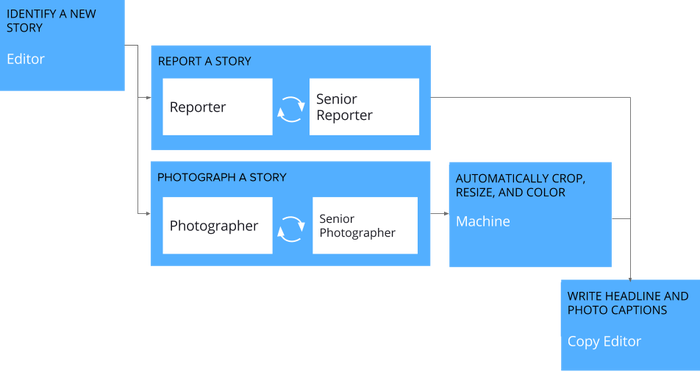Open-Sourced AI: The Next Big Step For The Gig Economy
January 18, 2018

Key takeaways
1. The freelance and 'gig' economy poses a number of big challenges for businesses and stakeholders alike, with significant implications for the world of work as a whole.
2. These challenges revolve around staff co-ordination, balancing internal and external teams of personnel, and efficient project management.
3. AI offers a path of maturity for the digital freelance model of work by automating rote tasks within project management and providing organizations with clear workflows for co-ordinating hybrid teams of internal and external experts.
NEW YORK, NY - As businesses grapple with the reality of a widening AI skills gap, the ability to quickly and flexibly leverage the right expertise at the right time is of growing concern. Today, enterprises big and small rely on digital platforms to supplement their wider sourcing strategies, reduce overheads, and see many projects through to completion. However, with big questions still to be answered about the implications for the world of work, some are looking to artificial intelligence technologies as the catalyst for a maturing gig economy model - as emerging business applications and use cases already seem to suggest.
For many, the gig economy is synonymous with the ridesharing model; technology platforms that act as a conduit between consumers and service providers. The story of the gig economy is not solely a story of technology, of course. This model has generated not only huge opportunities for businesses and workers, but challenges and controversy thanks to the disruptive effects of these technologies on different sectors and regional markets, as well as the regulatory and employment practices of some of the gig economy's biggest players.

Platform sourcing in the enterprise
This vision of a highly individualized, 'gig'-based model of work, in which freelancers compete with one another for contracts promises greater flexibility and freedom in work to some, and underlines the precarious nature of work in the 21st century for others. Large enterprises and Fortune 500 companies have recently begun experimenting with platform sourcing and incorporating these into their wider project strategies. These platforms can include crowdsourcing channels, which can be used to source ideas and solutions from large groups of people; 'microwork' solutions for rote tasks, such as Amazon Mechanical Turk; and online freelancing sites, like Upwork and Fiverr, which enable businesses to source highly-skilled freelancers for bespoke, knowledge-intensive projects in areas such as graphic design, software development, content, and much more.
A typical contracting process on one of these platforms can look something like this:
[caption id="attachment_10104" align="alignright" width="417"] Source: https://www.oii.ox.ac.uk/publications/platform-sourcing.pdf[/caption]
Source: https://www.oii.ox.ac.uk/publications/platform-sourcing.pdf[/caption]
A client posts a project on the platform and interested freelancers submit a proposal - or, alternatively, a client can approach a freelancer from the platform's database.
The proposals are evaluated and terms are agreed through the platform, which acts as a mediation channel for the project by compiling a contract.
Once the work is nearly completed, clients are able to review the draft project. Deliverables and subsequent payment are submitted through the platform.
One of the key strengths of platform sourcing is the flexibility it offers not only workers, but businesses too. Indeed, researchers claim that enterprises are looking for flexibility within the workforce in three different forms:
Numerical flexibility - the capability to rapidly adjust workforce size or the number of hours worked in response to product demand
Functional flexibility - enabling firms to apply their workforce to different tasks on the fly, which requires a much more varied skillset
Financial flexibility - a firm's ability to adjust their human resource costs in response to changes in the external price of labour
By giving companies the ability to maintain a core of regular employees and a periphery of flexible workers, freelance platforms enable firms to balance functional flexiblity with numerical and financial considerations.
Furthermore, by shifting the boundaries of what constitutes 'the firm', some have argued that they allow knowledge to flow into the firm in new and novel ways: "Rather than seeing knowledge flows across organizational boundaries merely as a threat, firms can make strategic use of it, allowing them to accumulate knowledge, innovate, and adapt faster to environmental changes. Online freelancing platforms allow firms to access workers with widely different skillsets, cultural backgrounds, and work histories, and are thus potentially an important new tool for knowledge creation and innovation."
New workforce models means new organizational challenges
However, there's a catch. In order to make a success of 'platform sourcing', companies need to consider new organizational arrangements that are able to address risks, prevent increased coordination costs, and ensure workplace practices are conducive to balancing internal with external work. Getting things right for all stakeholders requires a new, streamlined approach to project management.
"One of the trends today we've observed is that workers want flexibility in their work style. Some workers prefer to be employed full-time, some prefer to freelance, and others want to be able to work at different times of day and in different locations. The challenge with that model is that it requires a lot more coordination in order to staff and manage a project, and that's where AI can help," explains Adam Marcus, co-founder and CTO of B12.
[caption id="attachment_10129" align="alignleft" width="406"]
Adam is CTO and co-founder of B12 and has been the driving force behind the creation and development of B12’s open sourced Human-assisted A.I. engine, Orchestra.[/caption]
Founded in 2015, B12 are an intelligent software company pioneering new human-assisted AI models of work. Their open-sourced project management engine, Orchestra, promises a new kind of AI-assisted infrastructure that not only enables the automation of rote tasks, but the co-ordination of teams of expert personnel, or 'reviewers'. Right now, B12 offers a semi-automated web design service that promises to significantly cut overheads and project times for different businesses. Simply by logging onto b12.io and entering your company name, location, and sector, you will receive an automatically generated website within a matter of seconds. B12 is able to trawl the web and social media for any existing content about the business, extract it, and create a brand-new skeleton site.
This is where it gets interesting. Using a combination of AI technology and human experts, Orchestra is able to provide workflows, regular feedback, and complete project oversight to B12 clients. B12 applies Orchestra to web design right now, but plans to bring its approach to other products as well. "The way we think about what we do at B12 is that we're looking to build a brighter future of creative and analytical work," says Marcus. "This is an area that's very near and dear to my heart - it's the reason we not only created Orchestra, but open-sourced it."
Transforming project management with AI
The AI components of Orchestra can be broken down into four different areas. Firstly, it offers project scaffolding through 'flash teams', a research effort headed up by B12's Director of Product Daniela Retelny, forming the basis of her Ph.D dissertation at Stanford. Flash teams are digital teams of personnel drawn from internal, full-time experts at B12 and a carefully curated list of freelancers. Orchestra is able to automatically locate personnel by availability, experience, and skillset. "One of the things we noticed as a result of the experts on our platform being more distributed [in terms of location and work hours], staffing projects was actually really challenging. It used to take our project managers or customer success managers one or two hours to reach out to individual designers and ask them if they were available to work on a new project," Marcus explains.
One answer for B12 came in the form of StaffBot. After an initial scaffold is compiled to get the project off the ground, StaffBot completely automates the process of reaching out to experts who are likely to carry out the work in question - and, as a result, the company now claims to spend 'zero' hours of human time staffing projects. "We tend to be able to find a designer to work on a project in a matter of minutes, rather than hours. Just by having a machine provide you with this initial scaffold team for a project, you can achieve the same quality of work twice as fast. With the kind of work we do with our design product at B12, Orchestra is staffing internal full-time employees alongside freelance services all over the world."
Another AI function of Orchestra involves 'hierarchical review', originally headed up by Daniel Haas during an internship as he completed his Ph.D at Berkeley. Algorithms are able to identify the areas that project reviewers should focus their attention. "In our research, what we showed was that you can catch twice as many errors in work by having a machine identify where personnel should focus their attention," Marcus says. Hierarchical review not only identifies which areas need attention, but also pairs entry level workers with reviewers or more experienced experts in order to learn - an enhanced form of mentorship integrated into the project management tools.
[caption id="attachment_10031" align="aligncenter" width="589"] 5 Ways AI Will Change The Future of Work In 2018 [INFOGRAPHIC][/caption]
5 Ways AI Will Change The Future of Work In 2018 [INFOGRAPHIC][/caption]
A more empowered and diverse flexible workforce
On the horizon, there's an upcoming feature for Orchestra called SanityBot. This promises guardrails for each project. The bot notices when a project is going off track, identifying phases that are taking too long, response issues, or staffing failures - and identifies the project manager that something's going wrong. Then, the project manager can jump in and figure out a solution.
[caption id="attachment_10118" align="aligncenter" width="561"] An example of an AI-powered workflow in Orchestra[/caption]
An example of an AI-powered workflow in Orchestra[/caption]
It all fits into a core theme of automating rote tasks - from project oversight to personnel management. "Particularly in larger companies, there's a ton of overheads in coordination, in identifying the right people, in project management, or in doing repetitive tasks that tools like Orchestra can completely eliminate," Marcus says." The implications for workers could be profound. "I don't think the way to think about this is, 'oh, how do we automate a complete role or job away?'. It's about providing your teams with artificial intelligence assistance along the way. By eliminating a lot of the rote, repetitive work, you're going to be able to offer your employees or the people working on your platform a lot more mentorship opportunities with other experts, and a much greater ability to do things that only experts - humans - are positioned to do."
"In general, by having more flexible AI-powered project management systems, you're going to enable companies to offer more diverse work opportunities to the people working on their platforms, and to facilitate a more diverse workforce along the way. This can be accomplished through AI-staffed flash teams composed of full-time employees, freelancers, or whichever expert the system can find," argues Marcus. "Furthermore, you're going to be able to constantly push for a more and more expert workforce."
Open-source AI platforms like Orchestra are still in their early stages of maturity, but by opening up this technology to anyone who could benefit from it, B12 are offering businesses the tools to cut coordination costs, bolster project management, and create clear workflows for managing a more flexible, hybrid workforce - enabling a more efficient, equitable settlement for workers across the board. AI can - and will - be the conduit technology that ensures workers and enterprises are able to conduct business seamlessly and equitably.
Photo Credit: madfishdigital.com/ccimages.jpg
This article is part of our ‘Future of Work’ series for January 2018. Contact [email protected] for more information about how you can contribute or get involved.

Based in London, Ciarán Daly is the Editor-in-Chief of AIBusiness.com, covering the critical issues, debates, and real-world use cases surrounding artificial intelligence - for executives, technologists, and enthusiasts alike. Reach him via email here.
About the Author(s)
You May Also Like


.jpg?width=700&auto=webp&quality=80&disable=upscale)
.jpg?width=700&auto=webp&quality=80&disable=upscale)
.jpg?width=700&auto=webp&quality=80&disable=upscale)
.jpg?width=300&auto=webp&quality=80&disable=upscale)
.jpg?width=300&auto=webp&quality=80&disable=upscale)
.jpg?width=300&auto=webp&quality=80&disable=upscale)

